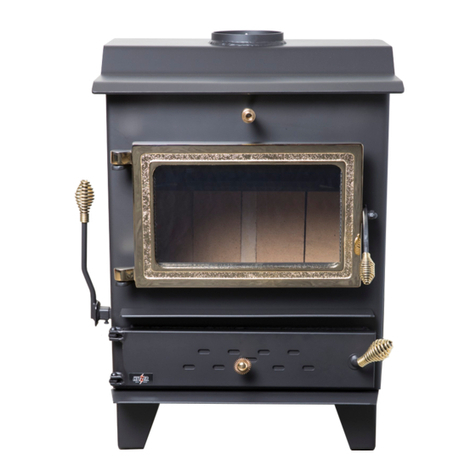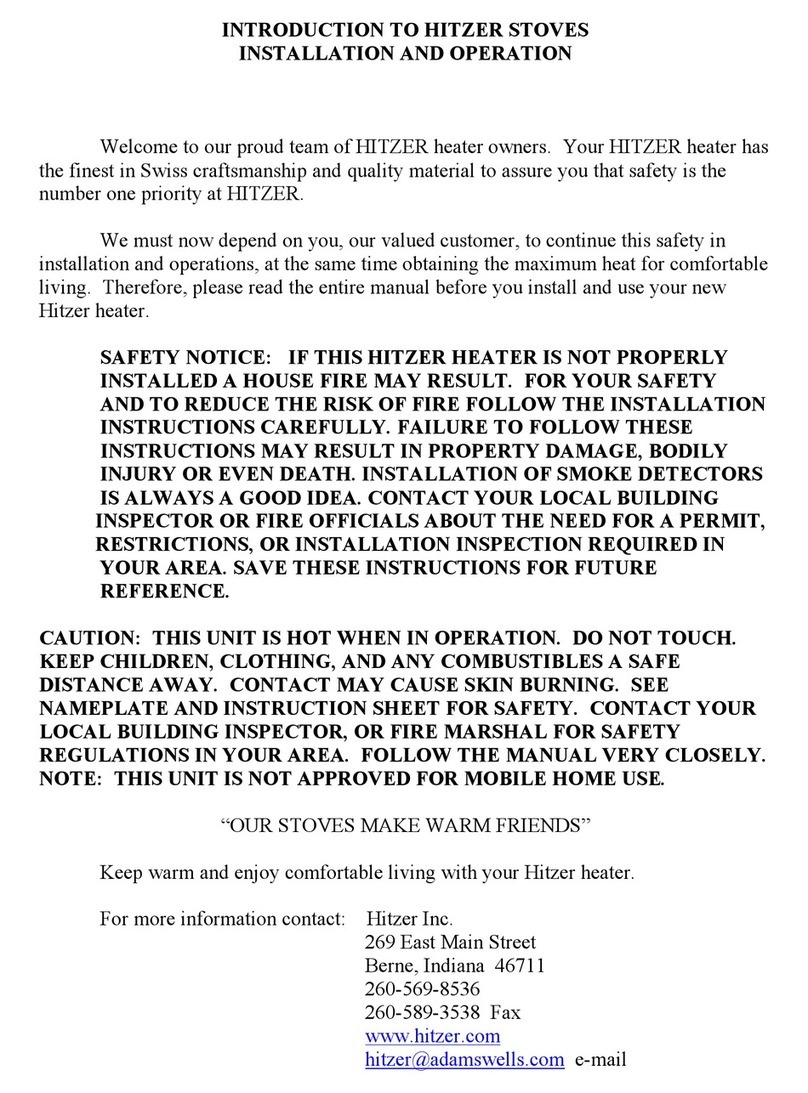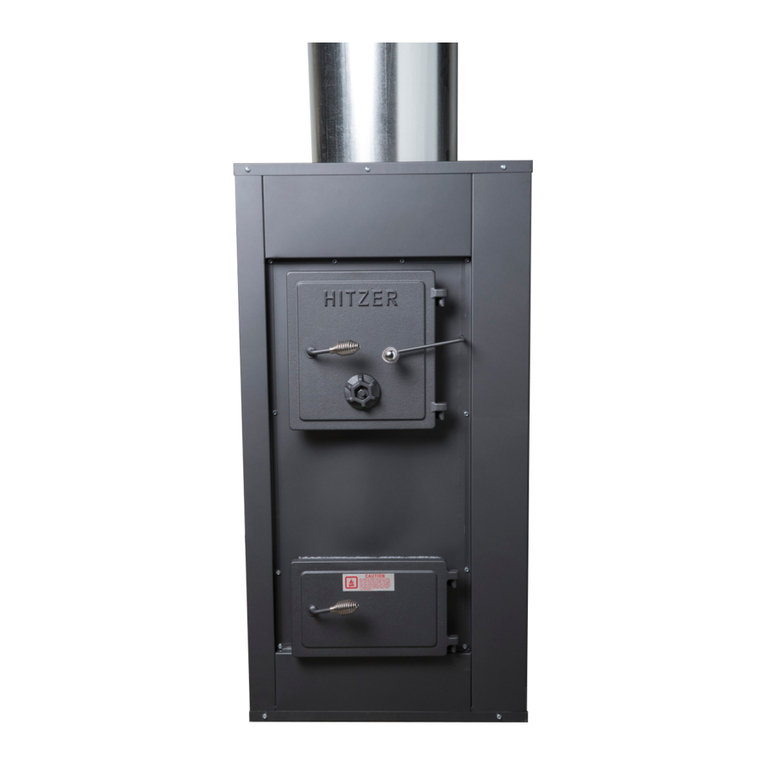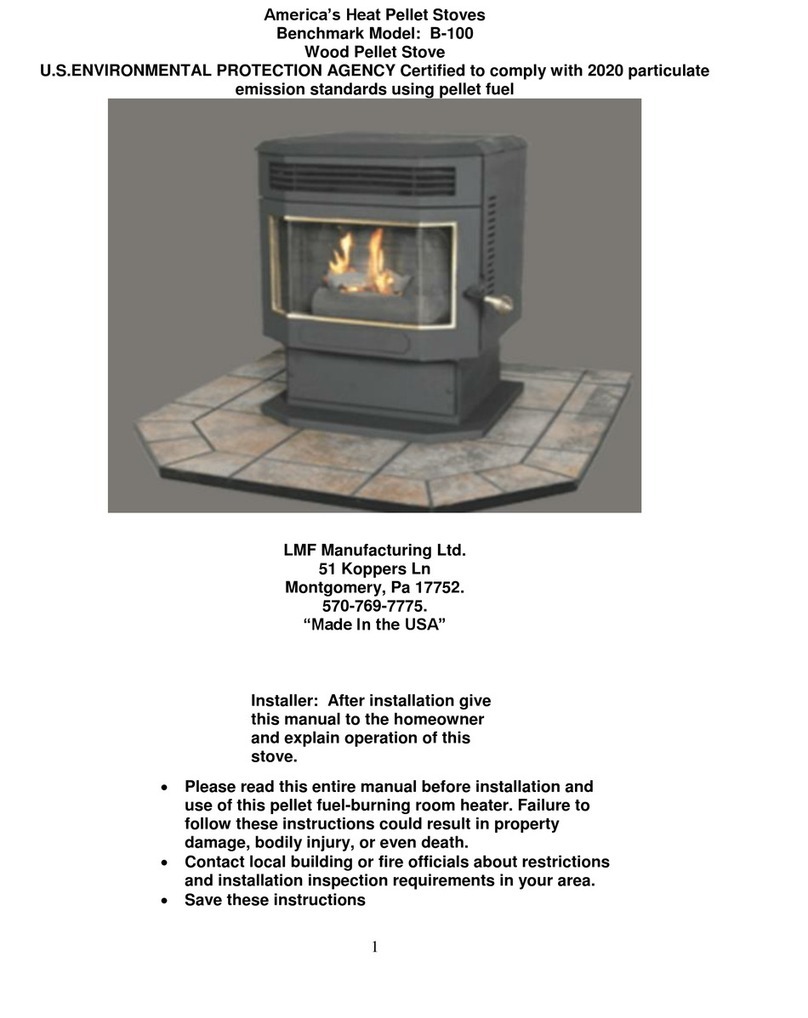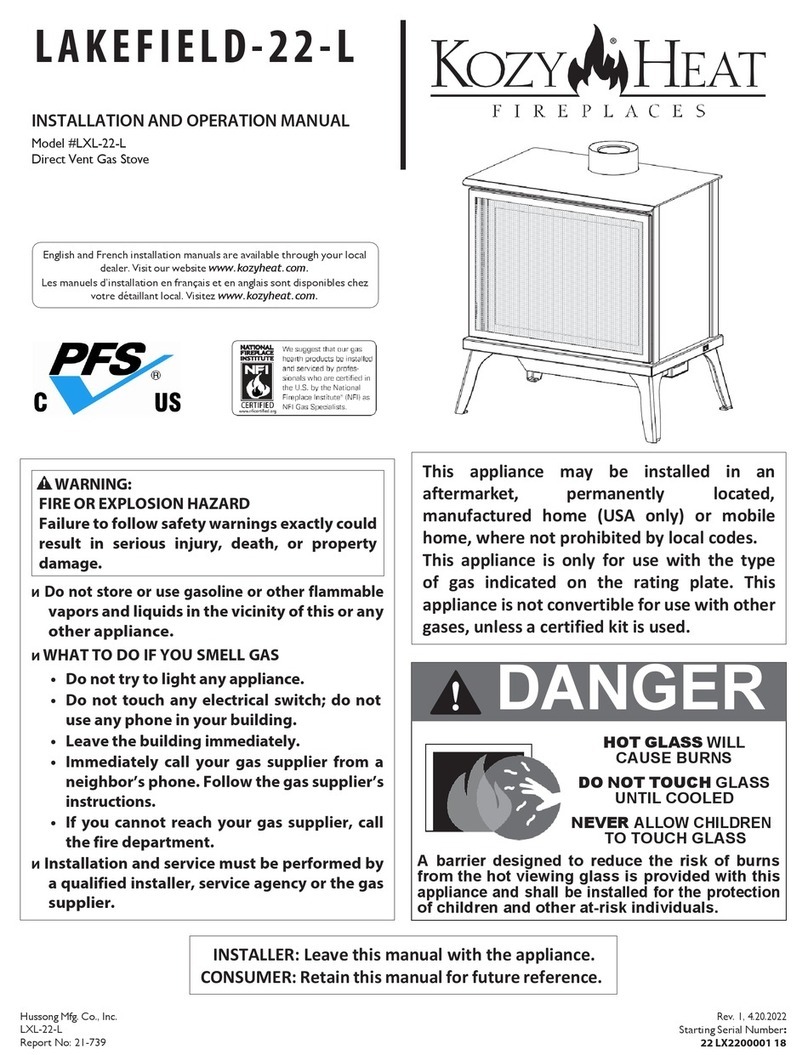Hitzer EZ-FLO 50-93 User manual

Page 1
INSTRUCTIONS
MODEL EZ-FLO 50-93
MODEL EZ-FLO 30.95
LOCATION OF STOVE
In order to achieve maximum circulation of heat produced by the stove, it is
recommended that the stove be centrally located. Remember that the heat will rise.
Therefore, if the stove is put next to a stairwell, much of the heat will rise to the second
floor before the ground floors are warm. One should consider the construction and layout
of the home to be heated and, therefore, make placement so as to achieve maximum
benefit from the stove.
CHIMNEY CONSTRUCTION AND MAINTENANCE
A good chimney is essential. This unit must be connected to either a listed type
HT (2100°F) chimney per UL 103 or ULC S629 or a code approved masonry chimney
with flue liner. The chimney size should not be less than the flue outlet on the stove, or
more than 3 times greater than the cross sectional area of the flue. Should you intend to
use an existing chimney for your stove, make sure that it is sound and has a flue lining
free from defects and corrosion. A chimney sweep should be consulted to assure there is
no existing creosote or soot build up present. Should the chimney lack flue tiles or if the
masonry is cracked, consult a mason about repairs or line the flue with a stainless steel
flue liner. Fire in an unlined or cracked chimney can spread into the house. The top of
the chimney should be at least 3 feet higher than the roof at the point of exit. With
pitched roofs, the top of the chimney must be at least 2 feet higher than any point on the
roof within 10 feet of the chimney. Check with your local building inspectors for local
building code compliances. The ideal installation would be for the chimney to extend
below the thimble with a clean out door.
The use of aluminum Type B gas vent for solid fuels in unsafe and prohibited by
the National Fire Protection Association Code.
Your chimney and chimney connectors should be inspected at least twice monthly
during the heating season to determine if a creosote or soot build up has occurred. If
material has accumulated, it should be removed to reduce the risk of a chimney fire.
Your chimney should be cleaned at least once a year. REMEMBER, a clean chimney
and a controlled fire will eliminate almost any chance of a chimney fire. Above all,
REMEMBER, if a chimney fire does occur, the fire department should be called
immediately and the draft control on the stove closed. DO NOT TAKE CHANCES BY
LETTING THE CHIMNEY BURN ITSELF OUT.

Page 2
INSTALLATION OF STOVE
CAUTION: DO NOT CONNECT THIS UNIT TO A CHIMNEY SERVING
ANOTHER APPLIANCE.
WARNING: THE INSTALLATION OF THESE STOVES MUST COMPLY
WITH STATE AND LOCAL REQUIREMENTS AND BE INSPECTED BY THE
STATE OR LOCAL INSPECTOR IF REQUIRED.
NOTE: These stoves are not approved for use in mobile homes.
Floor protection must provide insulation equal to at least 3/8 fiberglass millboard
and equal to or have an insulation factor or K-O-84 and must extent at least 8 inches on
both sides and rear of the stove, and 16 inches in the front of ash door.
CLEARANCE TO COMBUSTIBLES 50-93 Model 30-95 Model
Stove to Back Wall 28” 27”
Flue to Back Wall 18” 18”
Stove to Sidewall 20” 19”
Flue to Sidewall 32” 28”
Stovepipe must be at least 18 inches from combustible ceilings and or walls.
See label on stove before installation. The most important consideration in
installing your stove is adequate clearance between the stove and any combustible
surface. A stove that is placed to close to a wall or to furniture can cause a fire.
Connection of the stove to the chimney should be made as directly as possible and
not more than two bends when needed should be used. No reduction in flue pipe below 6
inches in diameter should be used. The pipe connecting the stove to the chimney should
be at least 24 gauge. Thicker gauges may be available and will resist corrosion longer
and need fewer replacements. Slope the flue pipe back towards the heater, ¼ inch per
foot of horizontal run. That way if any condensation forms in the pipe it will be carried
back into the heater. The connector pipe should be installed so that the upper pipe
section fits inside the lower section. This way any condensation building up inside the
pipe will stay inside the pipe as it flows down the inside surface. Horizontal pipe runs
should have the pipe seams turned up. Particular attention should be paid to the point
where the flue passes through a wall or ceiling. This penetration should always be made
with a thimble, insulated pipe, and the proper accessories following manufactures
instructions. Chimney connectors must not pass through the ceiling, concealed spaces, or
enter the chimney in the attic, unless proper clearance or insulated pipe is used following
manufacturers instructions. REMEMBER that all pipe sections should be connected with
at least 3 sheet metal screws per joint. A fire in the stack may cause vibration and poorly

Page 3
fastened piping may come apart causing an extreme fire and smoke hazard. Assure that
the chimney connections pipe extend at least 2 inches into the chimney, but does not
extend so far into the chimney flue that it blocks air flow. Where the pipe connects to a
masonry chimney, it must be cemented to the chimney, or a thimble must be connected to
the chimney and the pipe should be tightly inserted into the thimble without cement.
OPERATION YOUR E-Z FLO HEATER
CAUTION: USE ONLY THE TYPE OF FUEL SPECIFIED HERE AND ON
THE HEATER
Type of fuel for use in these units is either anthracite or bituminous coal. Nut size
or pea size are the recommended size of anthracite to use in this unit. Caution should be
used when burning pea coal as shaking the grates too far can cause the small coal to be
dumped into the ash pan thus wasting your coal. The Model 30-95, which has a
removable hopper, will also burn bituminous coal when hopper is removed. Never place
bituminous coal in the hopper. Bituminous coal does not work in the hopper feed system.
It is too volatile and will burn up into the hopper possibly overheating the stove and
ruining the hopper. Burning bituminous coal in the hopper will void your warranty.
Never burn it with your ash door open. This will void your warranty. Your stove will
burn out of control, causing damage to your stove and possibly to your home.
Kindling and small pieces of wood are required to use for igniting your coal when
starting your fire.
CAUTION: DO NOT USE CHEMICALS OR FLUIDS TO START FIRE.
NEVER USE GASOLINE OR KEROSENE OR ANY OTHER FLAMMABLE
FLUID WHEN STARTING OR REFRESHING YOUR FIRE. DO NOT BURN
GARBAGE OR FLAMMABLE FLUIDS.
NOTE: When your first fire your heater, the exterior paint will go through a curing
process. This may emit some smoke or odor. The first few fires should be small and
slow, this allows the paint to cure and the steel to temper. Adequate room ventilation
should be used in case of smoking.
NOTE: Keep ash door, glass fuel door, and hopper lid closed and sealed during
operation. Keeping any door open during operation may cause your appliance to over
heat and possibly result in damage to your appliance or a house fire. Operating this
appliance with doors open can result in carbon monoxide entering the house. Adequate
room ventilation is also necessary for the chimney to operate correctly. Room air
starvation can be caused by well-sealed vapor barrier and tight windows, exhaust fans, or
other chimney ventilated appliances. Room air starvation can cause your appliance to not
draw steadily, smoke rollout to occur, fuel to burn poorly, or back-drafts to occur whether
or not there is combustion present. It can also result in carbon monoxide not venting
properly or entering the house. Outside combustion air may be required. It is a very good
idea to install a carbon monoxide detector no matter what type of fuel you burn and what

Page 4
type of appliance you burn it in. Carbon monoxide is produced when burning gas, oil,
wood, coal, and anything else that burns and any venting problems can cause it to back
up into the house. Carbon monoxide is extremely dangerous and can result in serious
injury or even death
Starting your fire with anthracite coal:
To start your E-Z Flo open up the automatic damper on the rear of your stove to
number 10.You also need to open the slide damper in the ash door all the way.
CAUTION: BUILD FIRE ONLY ON INTEGRAL GRATE. DO NOT RAISE
FIRE BY ADDING ANOTHER GRATE.
Place crumpled paper and kindling wood on grate and ignite with a match or lighter.
Use a good amount of kindling wood as anthracite coal takes a hot fire to get started.
Watch your fire very closely. When the kindling wood is burning well, spread out over
grate area and add approximately 2” of coal over the entire grate area. As the coal starts
burning and glowing red add another layer of coal. Keep adding layers of coal waiting
between layers for each to start burning until coal level reaches almost the hopper
bottom. Now fill your hopper and close hopper lid.
CAUTION: MAKE SURE THERE IS NO COAL OR OTHER DERBIES ON
LEDGE WHERE HOPPER LID SEALS. IF HOPPER LID DOES NOT SEAL
STOVE MAY OVER HEAT AND POSSIBLY DAMAGE THE STOVE OR
CAUSE A HOUSE FIRE.
Adjust automatic draft control slide on the back of the stove for the amount of heat
desired. This control will hold the heat output at a given amount depending on the setting.
The higher the number the hotter the stove and the lower the number the lower the heat
output. Adjust control in small increments and let temperature stabilize approximately 12
hours between adjustments. Once desired temperature setting is obtained additional
adjustments are unneeded unless there is large changes in the outside temperature. Close
draft slide on ash door completely or it will eliminate the automatic temperature control.
The slide draft may be used in the event of a chimney being lazy and having very poor
draft. Opening it some will just help keep air moving through. Burn stove at the lowest
setting to produce the heat you need. This will increase the life of the stove and make
your coal last longer.
REFUELING
Open the ash door and shake the grates. You should shake the grates until you see bits of
red coals dropping into the ash pan the whole way along the grates. With bituminous coal
clinkers can form and it may be necessary to break these up to get them to fall into the
ash pan. They may also be removed through the main glass door with metal tongs and
placed in ash receptacle. Keep your hopper full. Should your hopper run empty add coal
very slowly so you will not choke out the fire. It is best to fill the hopper before it’s
completely empty. Once or so a week, as you see some dead ash building up along the

Page 5
sides, take a steel poker or steel rod and poke down that dead ash before you shake the
grates. This buildup happens because the ash under the hopper empties much faster
because of the weight of the coal on top. In order for the sides to keep up without some
help you would have to shake a lot of coal into the ash pan under the hopper
ASHES
You must keep your ashes cleaned out from under the grates. This may require emptying
your ash pan daily. This all depends on how hard you burn your stove and how often you
shake your grates. If there is not air space under the grates the grates will warp and
become inoperable. Remove and empty ash pan each time and make sure ash in pan does
not contact bottom of grates as this can cause the grate to warp. If fire seems sluggish or
is going out then not enough ash has been shaken out. Ashes should be placed in a metal
container with a tight fitting lid. The closed container of ashes should be placed on a
noncombustible floor or on the ground, well away from all combustible materials,
pending final disposal. If the ashes are disposed of by burial in soil or otherwise locally
dispersed, they should be retained in the closed container until all cinders have
thoroughly cooled.
MAINTENANCE
NOTE: Failure to maintain or properly use this appliance may cause a house fire.
At the beginning of each heating season this appliance, the connector pipe, and chimney
should be inspected to see that it is in good working condition.
Prevent Soot and Creosote Fires:
When coal is burned, the products of combustion combine with moisture to form a
soot residue, which accumulates on the flue lining. When ignited, this soot makes an
extremely hot fire. When wood is burned it produces tar and other organic vapors, which
combine with expelled moisture to form creosote. The creosote vapors condense in the
relatively cool chimney flue of a slow-burning fire. As a result, creosote residue
accumulates on the flue lining. When ignited this creosote makes an extremely hot fire.
Chimney connector and chimney should be inspected at least once every two months
during operation to determine if a build up has occurred. If buildup has occurred it must
be removed with chimney cleaning chemicals and a chimney brush or contact a local
chimney sweep.
Blowers:
If your unit is equipped with blowers should be cleaned of dust and dirt
periodically. Replace only with original blower available from your Hitzer dealer.
CAUTION: ALWAYS DISCONNECT UNIT FROM POWER SOURCE BEFORE
ATTEMPTING TO SERVICE OR REPLACE ANY ELECTRICAL SYSTEM
COMPONENTS

Page 6
Care and replacement of glass:
Never strike the glass or slam door shut as such abuse can damage the glass and
cause it to fail. Never operate your appliance with broken glass. Never attempt to clean
glass when hot. Never clean glass with harsh abrasives. Replace glass only with ROBAX
CERAMIC glass (30-95 5mm x 9” x 15 9/16”, 50-93 5mm x 9” x 17 7/16”) available
from your Hitzer dealer. Use of any other type of glass can cause glass to fail creating a
fire hazard
Should you be required to replace the glass first remove door from your stove and
lay face down on a smooth solid surface. You will want to pad the surface especially if
you have the optional plated door so as not to scratch the finish. Remove and save the
glass retainers and screws. Carefully remove all broken glass and sealing gasket material.
Install new glass using new sealing gasket material and reinstall all glass retainers and
screws.
Optional gold plating;
The gold plating option is real gold. Gold is very soft. Any abrasive type cleaner or
polish will destroy the finish. It is best to use a clean, soft, damp cloth or a clean, soft
cloth and window cleaner to clean any of the plated parts.
Fuel storage:
Coal does not absorb moisture as much as wood so coal can be easily stored outside.
It is a good idea to build a bin, in your garage, basement, shed, or even outside if you are
getting your coal in bulk. This will keep coal contained and not spread out all over the
floor. If stored outside it is a good idea to cover your bin with a tarp to keep out a lot of
snow. A estimate on size is a bin 4 feet wide by 8 feet long by 4 feet high will hold 3 ton
or a little more of nut size anthracite coal. Bagged coal can be stored anywhere inside or
out.
This manual suits for next models
1
Table of contents
Other Hitzer Stove manuals
Popular Stove manuals by other brands

Aarrow
Aarrow Stratford Sf 50 Convector Installation & operating instructions
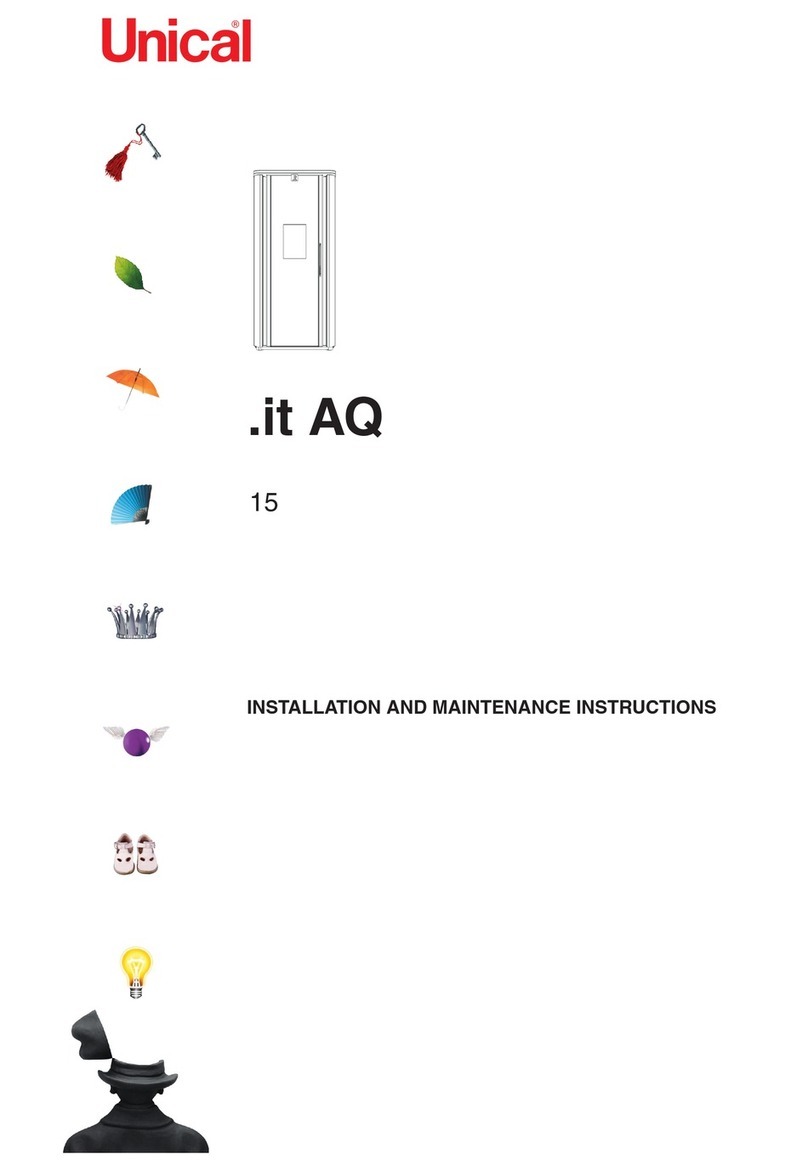
Unical
Unical .it AQ 15 Installation and maintenance instructions
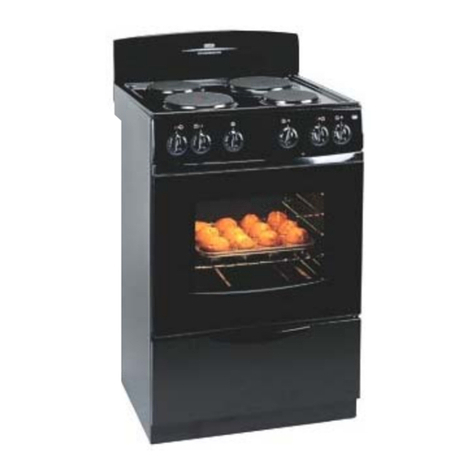
Defy
Defy Sbw owner's manual

RIKA
RIKA COOK operating manual
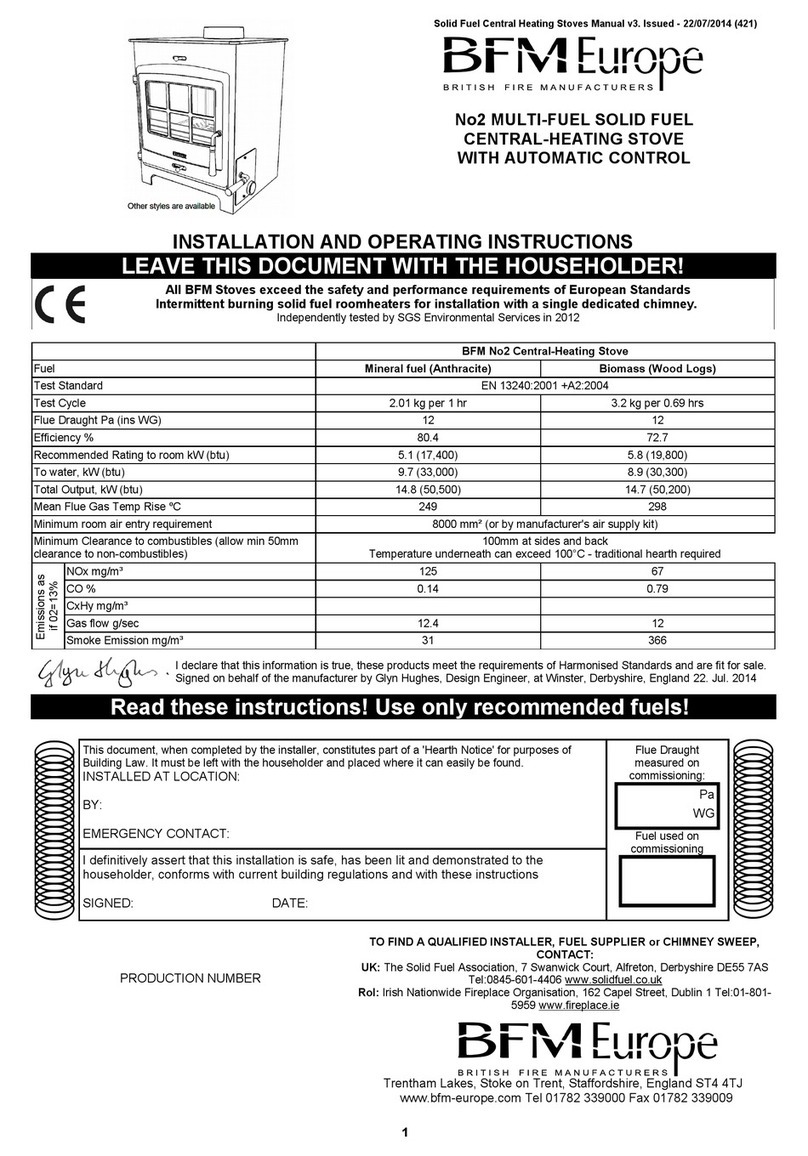
BFM
BFM No2 Installation and operating instructions

Vermont Castings
Vermont Castings Addison 2905 features and benefits

INIS Stoves
INIS Stoves InisBofin User and installation manual

Moretti Design
Moretti Design ARIA TURBO ERGONOMIC CLEAN GLASS A 9 DEDICATED MANUAL
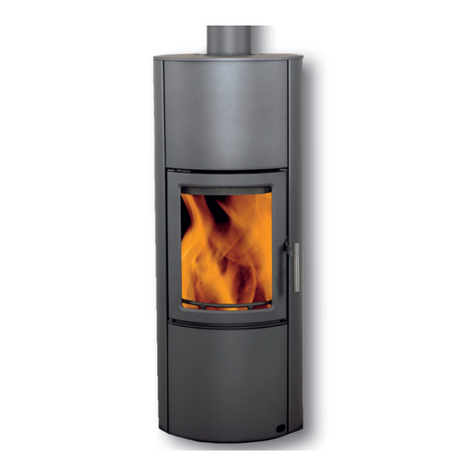
Heta
Heta SCAN-LINE AQUA operating instructions
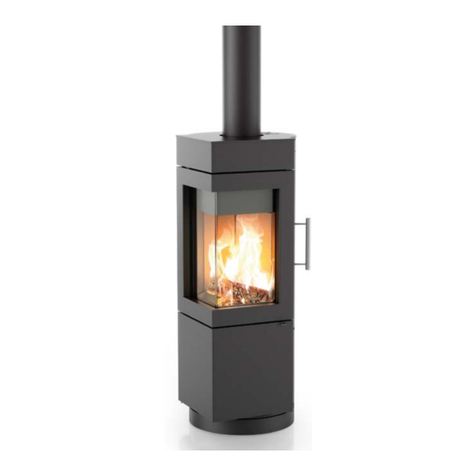
HASE
HASE Kano Instructions for use

Quadra-Fire
Quadra-Fire 3100 Millennium owner's manual

Camp Chef
Camp Chef Yukon YK60LW instruction manual

